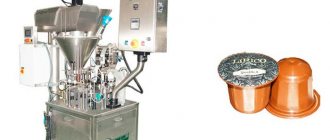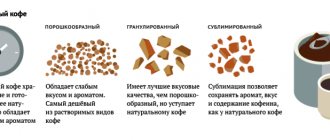Coffee is not called a drug for nothing. People drink it in the morning, at lunchtime, and sometimes in the evening. Such a ritual helps to cheer up, concentrate attention, improve performance, and lift your spirits. To prepare a hot or cold aromatic drink, connoisseurs use their favorite varieties and types of roasted and ground grains. Among the “dependent” countries in terms of coffee consumption per capita are Finland, Norway, and Iceland.
Sweden: 8.2 kg per capita
In Sweden there is such a thing as “fika”, which literally means “to drink coffee”.
Various sweets or baked goods are also allowed. This concept can include a variety of situations - from a break at work to a gathering of friends.
Of course, you can drink coffee alone at home, but more often this drink becomes part of social interaction.
Statistics of coffee consumption in the world
Finland ranks first in the world. Annual product consumption per person is more than 9 kg. In India and China they do not favor the drink - 0.1 kg. TOP 5 countries for coffee consumption:
- Finland – 9.6 kg;
- Norway – 7.2 kg;
- Holland – 6.7 kg;
- Slovenia – 6.1 kg;
- Austria – 5.5 kg.
The world leader in the production of the drink ranks 10th in the ranking. Per capita coffee consumption in Brazil is only 4.8 kg.
The annual growth of indicators in the world is also facilitated by the increase in the number of coffee shops. Moreover, the situation differs across countries. For example, the rate of drink consumption in the countries of the former Soviet Union is about 1 kg per year (Ukraine - 1.4, Belarus - 0.6). However, global coffee consumption per capita is growing annually by 3–4%.
Iceland: 9 kg per capita
Perhaps there is some connection between the cold climate and the love of coffee.
Icelanders are also among those who drink the most coffee. On average, an Icelander drinks up to 5 cups of coffee a day.
The capital of Iceland does not have large coffee chains such as Starbucks or Second Cup, but there are many small coffee shops that brew the best quality coffee.
What is known about the elixir of vigor?
The fruits of the coffee tree were known as early as 850. However, it was only centuries later that the grains gained universal recognition. In Russia, they were originally used as a remedy for certain diseases. Statistics on coffee consumption in Russia began at the beginning of the 18th century. Peter I introduced the fashion for the drink among the nobles. Coffee Facts:
- The edibility of the plant's fruits was discovered by the Ethiopians. They noticed that herds of goats happily consumed the berries;
- contains many useful substances (as a percentage of the daily value): potassium, manganese - 3%, vitamin B5 - 6%, B2 - 1%;
- The calorie content of the drink is 2 kcal per 100 ml;
- consuming ground coffee immediately after waking up prevents the formation of cortisol in the body (the hormone responsible for alertness and concentration). Therefore, it is recommended to drink the drink closer to noon.
International Coffee Day is October 1st. However, in some countries the holiday is celebrated at a different time. Coffee consumption remains common - as a tribute to the love of the drink.
Serbia – 5.4 kg of grain (1.51 cups per day per person)
Serbs are known for their love of drinking Turkish black coffee with Turkish delight, a sweet made from nuts, fruits, flour and powdered sugar. Making Turkish coffee is a special process. Finely ground coffee should be immersed in very hot water.
When the water boils, the Turk should immediately be removed from the burner for a couple of minutes. This procedure is repeated two or three times, then the unfiltered drink is poured into cups. Although it takes much longer than preparing regular coffee, it must be worth it if Serbs prefer this recipe over all others.
When breastfeeding
Statistics on coffee consumption in Russia show that the drink affects the baby’s body through mother’s milk. Therefore, a logical question arises: is it possible to drink coffee while breastfeeding? The key is the number of drinks you drink. The rate at which caffeine is eliminated from the body depends on the age of the baby:
- premature babies – 65–103 hours;
- up to 3 months – 80–97 hours;
- from 3 to 6 months – 14 hours;
- over 6 months – 5 hours.
The maximum concentration of caffeine in breast milk after a serving of coffee is reached after an hour, and is completely eliminated from the body after 5–6 hours. Therefore, consumption of the drink during lactation is undesirable.
How do Russians choose coffee?
Our compatriots have established a certain plan according to which the majority chooses their drink. Among them are the main criteria:
- In terms of quality (nowadays many people know what high-quality grains should look like);
- Popularity of the brand;
- Country of origin (more often the choice falls on Brazil and Italy);
- Competent advertising policy;
- High-quality packaging;
- Price category.
Quality comes first for our citizens. This explains the weak transition to cheaper brands, even during the crisis. In order to save money, people simply buy their favorite brand in smaller quantities.
Soluble is in demand only in the case of a competent advertising campaign.
Problems with entering the market
For companies seeking to gain a foothold in the Russian market, there are several specific barriers that must be taken into account.
Firstly, there is the language barrier. International producers and roasters will have a hard time finding English-speaking Russians. Most Russians will never leave their home country, and most foreign media is translated or duplicated.
For this reason, most residents simply do not need to learn English.
“This is mainly due to the lack of opportunity to practice English during the Soviet period and in Russia in the 2000s. Personal relationships are very important in Russian culture, so it will be very difficult to build a sustainable partnership in a country where 5% of Russians speak English. There is a lot of hope for the younger generation, but this is a long-term story,” Drago clarifies.
Another thing to consider is that specialty coffee consumption is linked to economic growth. Solvency can be highly volatile as the Russian economy is highly dependent on oil prices.
“Coffee by nature is dependent on international trade and relationships between countries. The consequences of global processes affect Russian business and make it difficult to manage,” says Drago.
To thrive, the coffee industry needs a strong consumer base with ever-increasing disposable income. But the problem is that, in fact, the disposable income of Russians has been declining over the past five years.
Austria – 5.5 kg of grain (1.51 cups per day per person)
Austria is known as the birthplace of waltzes, classical composers and Viennese coffee houses. The first coffee shops were opened in 1638 and since then they have been famous as special places with a unique atmosphere. Often in these coffee shops, coffee is accompanied by savory dishes, or a variety of sweets, such as the famous Linzer cake.
Austrians love to visit these places, some do it regularly, not only to drink coffee, but also to read the free newspapers that are distributed right there in the cafe.
If you're in Vienna, be sure to try Karsemelange (or Imperial Mix). It is made like this: hot coffee is slowly poured into a mixture of egg yolk and honey and decorated with creamy foam. If you don't need to be sober, order an original drink with added brandy.
Varieties of grains on the world stage: Arabica and Robusta
Arabica is preferable to Robusta; it is famous for its exceptional sophistication, which is why this type is very popular among the inhabitants of our planet. Arabica trees are very capricious, they require special care and climate: they feel good only in the highlands, they are more susceptible to diseases, and they are often attacked by pests. The optimal altitude for growing Arabica is 2000-2200 meters above sea level. Ecuador is considered the highest mountainous region for growing Arabica. There, fruit trees grow at an altitude of 2700-2900 m, and the grains are known for their good quality and exquisite taste.
Robusta is not so demanding to grow; this variety can grow well at an altitude of up to 700 m. The main suppliers of robusta can be considered India, Africa and other tropical regions of our planet. Robusta is more complex than Arabica in its composition: it contains more caffeine, and therefore, it is more often used to prepare strong drinks and mixtures. This variety is distinguished by its low price.
To get 1 kilogram of fried and ready-to-eat product, about 4.5 thousand fresh grains are used. Moreover, one plant in Brazil produces about 2 thousand grains per year.
Cereal products
During the 2015 crisis, a small proportion of citizens changed the brand to a cheaper one of the same bean coffee. This is explained by the fact that Russia has jumped into the era of quality products, because now everyone knows that whole grains are healthier.
The share of domestic trade turnover accounts for 66% of natural coffee produced by Russian companies. Among them:
- "Orimi Trade"
- "Moscow coffee shop on shares"
- Tea and coffee shop
Foreign firms such as Paulig are also present. This Finnish company recently opened a bean roasting plant in the Tver region. The income of this company can be considered one of the largest.
Export to Russia
Russian companies have been exporting finished products to European countries and the CIS for a long time. Foreign companies are interested in:
- Naturally roasted product with caffeine (about 75% in granulated and ground form);
- Arabica (23%);
The main exporting countries are the former Soviet republics - Belarus, Abkhazia and others. Until recently, the largest consumer of Russian products was Ukraine (69% of exports), but due to difficult political relations this percentage has decreased significantly.
In Russia, the most important exporters are two capitals - Moscow and the region (45%), St. Petersburg and the region (40%). About 52 domestic companies operate in this specialization. But only 4 of them are large and take up about 85% of all processing.
Finland
Scandinavians in general, and Finns in particular, are considered the world's most avid coffee drinkers. They use it more than any other nation in the world. Most often, very strong espresso is on the menu of Finnish residents, but they often treat themselves to traditional kaffeost coffee - black, with salty cheese cubes, which are added directly to the cup, like marshmallows.
Scandinavia
In Denmark, Sweden and Norway, local herbal and berry teas are popular; they are served with fruit and berry syrups.
Swedes and Norwegians add the same syrups to coffee, which is not brewed here very often. Typically, Scandinavians brew coffee in a French press by pouring hot water over the powder and then passing it through a filter.
In Scandinavia, you will never be able to tell by taste what roast or what country the coffee was brewed for you, since you will only smell the aromas of syrups and the slightest aroma of coffee. Moreover, with a cup of tea or coffee in Copenhagen, Stockholm or Oslo, you will certainly be served a scattering of some cookies and several rosettes with various jams. Here it is customary to spread jam on cookies, and then wash down this sandwich with tea or coffee with syrups.
Cooking methods
To prepare the drink, special utensils and mechanized means are used - cezve (Turkish), coffee pots, coffee makers and coffee machines. Coffee recipes combine traditions from different countries:
- Italy. The country is the birthplace of espresso. There are strict requirements for preparing the drink - a cup of coffee must be ellipsoidal in shape and no more than 75 ml in volume. The foam should cover the entire surface and be of a certain color.
- Ireland. Irish coffee was invented by D. Sheridan at the beginning of the twentieth century. The drink should contain a small amount of whiskey and cream. The dairy product is added using the convex side of a spoon. The strength of the drink is 12–15 degrees, calorie content is 250 kcal.
- Bavaria. Bavarian coffee uses egg yolks, gelatin, and milk. The drink is not brought to a boil. It is removed from the heat at a temperature of 82–85°C.
- Türkiye. Turkish coffee is widely known in North Africa, the Middle East, the Balkans, and the Caucasus. Traditionally, the drink is prepared in a Turk and served in small cups. Recipe proportion – 1 g. coffee for 7 gr. water.
Türkiye
You are served in a small porcelain cup decorated with oriental patterns, coffee black as oil, enchanting with its aroma.
Türkiye is famous for its coffee, which is brewed in a Turk. Residents of this country, like Italians, drink coffee separately from food, enjoying every sip. Turks brew coffee on hot sand or hot coals in skillfully made pots. The drink is served in small cups with Turkish delight or candied fruits and nuts. They always bring a glass of water with coffee, which you need to drink before tasting the drink in order to cleanse your receptors of unnecessary tastes. The population drinks coffee without sugar; it is believed that those who drink the drink in its pure form have a strong character.
In other countries, people often drink coffee, get a dose of energy and go about their business. For the Turks, everything works differently: they slowly enjoy a drink, stopping the bustle of the city for themselves.
Turkey has many traditions related to coffee that have been formed since ancient times. The ability to brew delicious coffee was considered a valuable and important skill; before, girls were specially taught all the intricacies of preparing this drink. This skill increased the girl’s bid at the bride fair, and it was this skill that grooms primarily wanted to see in their future wives even at the engagement stage. This custom still exists in some Turkish families.
There is also a tradition that involves telling fortunes using coffee grounds; there is always at least one person in the company who knows how to do this. The essence of fortune telling is to decipher the patterns from the coffee grounds that remain after drinking the drink. In coffee shops you can consult a fortune teller, whose services are often included in the price of a cup of coffee.
Selling coffee
The distribution of products among retail outlets and centers has its own characteristics. The number of hypermarkets, regular stores and Cash&Carry is growing every day. Depending on what needs to be sold, the appropriate point of sale is selected. So, if you need to sell loose or bagged tea, then the importance of trading channels is much higher for the first option.
The situation with coffee is different; grain coffee is in greater need of popularization, while instant coffee can be purchased even in a simple food stall. If you need to buy decoupage, it will be easier to find it in small branded stores or specialized markets.
When considering instant products, the analysis shows that their share in interstate channels is 36%, while grain occupies about 50%, and decoupages - only 17%.
It is difficult to replace coffee and tea with other drinks. Therefore, even in conditions of a severe crisis, their value remains unchanged. Under the most difficult circumstances, people will switch to cheaper types, but not abandon them.
World coffee production for marketing year 2019/20
Global coffee production for the 2019/20 marketing year (MY) is forecast to be 5.3 million bags (60 kg) lower than the previous year, falling to 169.3 million, mainly due to the fact that Brazilian Arabica trees enter the off-year period of their two-year production cycle.
Table 1. World coffee production
World coffee production, according to USDA Global
exports are expected to decline by 4.7 million bags to 115.4 million, mainly due to lower supplies from Brazil and Honduras.
With global consumption forecast at a record 166.4 million bags, ending stocks are expected to fall by 400,000 bags to 35.0 million.
Coffee prices, as measured by the International Coffee Organization's (ICO) monthly composite price index, fell to $0.93 per pound in May 2021, the lowest level since September 2006. But by November 2021, they recovered by 15 percent to $1.07 per pound due to reduced supplies.
map of coffee producers and importers
in Brazil is forecast to fall by 8.3 million bags to 39.9 million compared to the previous season, as most trees are in the off-year period of the two-year production cycle. Good weather conditions generally prevailed in most coffee-growing regions during the flowering and fruiting stages.
The robusta crop is forecast to continue to grow, reaching a record 18.1 million bags, up 1.5 million. Good rainfall supported fruit development in the main producing state of Espirito Santo, while good crop management practices contributed to the steady growth of the state of Rondonia.
The combined Arabica and Robusta harvest is forecast to increase from 6.8 million bags to 58.0 million.
Vietnam's production is forecast to reach a record 32.2 million bags, up 1.8 million from the previous year, as acreage continues to expand as well as favorable weather boosting yields.
Due to the fall in black pepper prices over the past 3 years, farmers are no longer replacing coffee trees with pepper. However, some farmers have started planting durian, mango, avocado and passion fruit trees in their coffee gardens.
Italy
What do you associate Italy with? Coffee lovers will exclaim: “In Italy they know how to brew delicious coffee!” The first coffee machine and the first espresso appeared in this country, which they are very proud of, it gained popularity in most countries. Espresso is the king in the world of coffee and a huge number of coffee drinks are made based on it. Until now, Italians love coffee and do not deny themselves this pleasure every day. In Italy, dark roasted grains are usually used, this contributes to a pronounced bitterness in the taste of the drink.
And while the specialty industry is developing all over the world, Italians continue to drink dark-roasted Robusta.
Residents of this country begin their day with a cup of cappuccino, no later than 12 noon. Italians consider this drink too high in calories due to the large amount of milk. Then during the day they drink espresso or ristretto, exclusively after meals. They consider coffee a separate part of the meal, go to a bar for a cup of drink, loudly order caffè, drink at the bar and go on about their business. In Italy, it is not customary to sit for a long time in an establishment over a cup of coffee and take drinks to go.
Italians are not conservatives, sometimes they go for experiments; in Rome they drink espresso with a slice of lemon, which must be crushed with a spoon against the wall or bottom of the cup. Lemon gives the drink a pleasant acidity and a refreshing effect.











